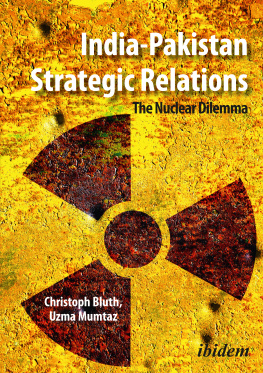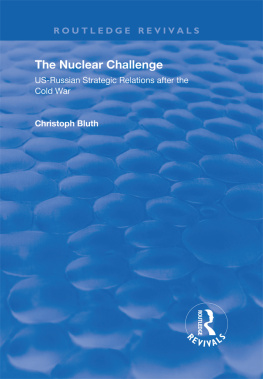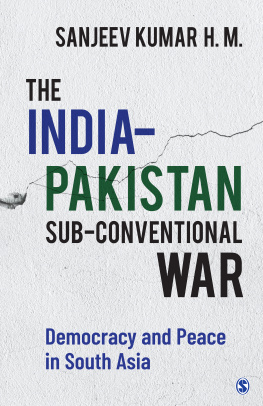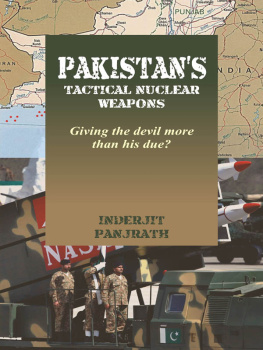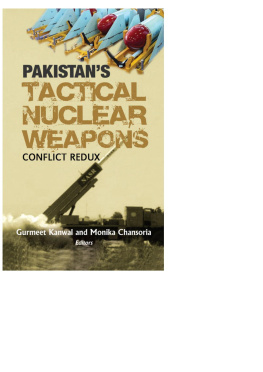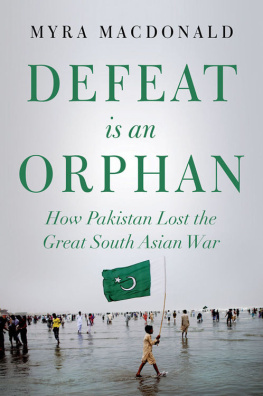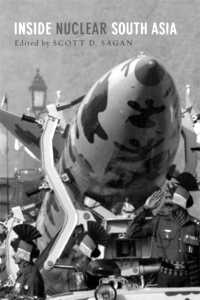ibidem -Press, Stuttgart
Table of Contents
Chapter 1: Introduction
In February 2019, forty Indian soldiers were killed in an attack on a convoy of paramilitary forces in Indian-controlled Kashmir. The attack was claimed by Pakistani militant group Jaish-e-Mohammad which has acted as a proxy force for the Pakistani Inter-Service Intelligence services. The Indian government responded with air strikes against what they claimed was a terrorist training camp inside Pakistan two weeks later Pakistan responded with air strikes on targets in Indian-administered Kashmir that was followed by direct engagements between the Indian and Pakistani air forces in which two Indian aircraft were downed and one Indian pilot was captured. The confrontation gave rise to speculation about the dangers of escalation to a nuclear conflict. The events of 2019 encapsulate some of the key issues in the tense relationship between India and Pakistan and the extraordinary risks in a strategic relationship which is unique in international politics in that two states with small but significant nuclear arsenals still engage in direct armed conflict. South Asia exhibits many of the phenomena that give rise to insecurity, including a major rivalry between two nuclear powers, proxy conflicts, terrorism and the involvement of outside powers. For this reason the strategic relationship between India and Pakistan is of special interest to scholars interested in international security, as it seems to embody so many exceptions to many of the paradigms of the discipline. This study takes a new look at India-Pakistan strategic relations on the basis that the existing academic literature has not adequately explained either the anomalies nor the strategic risks inherent in the persistent conflict between these two nuclear armed rivals. It aims to identify the key drivers of the strategic relations, reassess the risks to strategic stability and discuss the conditions under which the hostility between the two regional rivals could be overcome.
1.1 India and Pakistan: The enduring conflict
The conflict between India and Pakistan predates the creation of these states out of the British empire. Under the British rule, Hindus and Muslim engaged in the struggle for independence together under one leadership. When it came to the power sharing in one governmental structure, however, Muslims became suspicious of Hindu policies as they were of majority and leadership was Hindu and polices were also seemed to have Hindu tilt. As a result, of the suspicions and mistrust the Muslims decided to form their own party, the Muslim league. It was in 1930 when idea for separate Muslim homeland was introduced on the basis of the Two Nation Theory, and then the rift between Muslim and Hindus widened due to communal clashes between Hindus and Muslim. The then viceroy Lord Mountbatten concluded that the only solution is to divide the subcontinent into two separate states, a Muslim Dominion of Pakistan and a secular Union of India, which was predominantly Hindu. The partition was accompanied by communal violence in which according to various estimates up to 500,000 people died. The British expected that the princely state of Jammu and Kashmir would become part of Pakistan, but ruling Maharaja failed to make a decision. After Muslim rebels and Pakistani troops entered Kashmir the Maharaja sought help from the British but was told by Lord Mountbatten he could not expect British assistance until he formally acceded to India. After the Maharaja signed the instrument of accession, Indian troops entered the territory and ejected the irregular forces from most of the territory. The 1947-48 Indo-Pakistani war over Kashmir in which around 8,000 soldiers were killed ended with India controlling about half the former princely state of Kashmir and Jammu, while Pakistan occupied the Northern Territories and Azad Kashmir. A ceasefire line was established and monitored by United Nations until 1972. It was then renamed the line of control (LOC) and manned by troops of the opposing sides. A United Nations mandate to hold a plebiscite in Kashmir to determine its future has consistently been rejected by India, whereas Pakistan has never accepted that part of Kashmir belonged to India. Three major wars and one minor war have been fought (1947-48, 1965, 1971 and 1999) without either country changing the status quo to its advantage. The conflict between India and Pakistan has been persistent and has continued despite dramatic changes in the geopolitical environment. The conflict between India and Pakistan is over national identity, the power position in the region and national identity simultaneously. India sees itself as a secular state that incorporates Hindus and Muslims, but without Kashmir there would be no significant Muslim population in India. The Pakistani perception is that India has never fully accepted partition or Pakistans right to exist as a separate state. India sees itself as the Great Power and Pakistan sees itself as the victim of Indian hegemonic ambitions, while India sees an irredentist Pakistan as the source of instability in the region. The conflict is characterised by a significant power asymmetry. Indias population and national economy is more than seven times that of Pakistan, and its territory is fourfold that of Pakistan. With the increasing growth of the imbalance in military power Pakistan has resorted to asymmetric strategies (such as the use of proxies and insurgent fighters) and external alliances to continue its struggle against India. In the context of strategic asymmetry, the weaker sign can often gain a temporary advantage by initiation a crisis and upsetting the status quo, especially if it shows greater resolve and is prepared to assume greater risks, but may still have difficulties in translating these gains into a long-term advantage. This clearly has been the pattern of Pakistans challenge to Indias refusal to deal with the Kashmir issue, although India has also engaged in various provocations. The conflict has shaped the power structures in Pakistan and has given the army a decisive role in the running of the country because of the conflict with India. The consequence is that the political and military elite remains strongly wedded to pursuing the conflict with India over political status and territory because its identity and status in society depends on it.
1.2 India, Pakistan and nuclear weapons
In order to balance Indias conventional military superiority, Pakistan acquired a small-scale nuclear weapons capability using bombers and medium range missiles as delivery vehicles. India had a significant nuclear industry and had demonstrated its capacity to explode nuclear devices already in 1974. Whereas Pakistans nuclear weapons doctrine is Indo-centric, India acquired a nuclear capability as part of an ambition to be recognized as a Great Power and seeks to deter not only Pakistan but also China.
The acquisition of nuclear weapons by both India and Pakistan raises the spectre of a regional nuclear conflict with catastrophic consequences. However, there is a widespread view in the strategic studies community that nuclear weapons are likely to prevent armed conflict due to the effects of nuclear deterrence and the unacceptable risks that the protagonists face in the event of war This study is concerned with the effect of nuclear weapons on the security crisis in South Asia.
The core issue to be addressed by this study are the policy objectives and other factors that determine the strategic arms policies of India and Pakistan and the extent to which that strategic relationship between India and Pakistan is stable. There is no clear consensus in the literature given that at least on the surface the generally accepted principle that nuclear states do not go to war with each other does not seem to apply in this case. The strategic studies literature asserts that strategic stability exists if two protagonists have a secure second strike capability that is sufficiently large to inflict unacceptable damage on the opponent and thus can deter aggression. This means that there is a serious risk of conflict escalating to the nuclear level.

